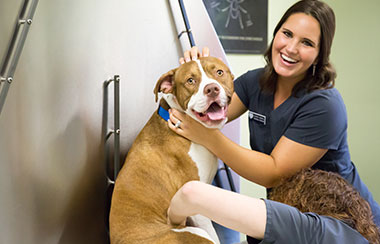
Neutering for Dogs
Why should I have my dog neutered?
Neutering should be considered if you are keeping any male dog as a pet. Remember that Guide Dogs for the Blind, Hearing Dogs for Deaf People, and Dogs for the Disabled are routinely neutered.
What are the advantages of neutering my male dog?
• Reduces the risk of prostate cancer and prostatitis
• Reduces the risk of hormone-related diseases such as perianal adenoma
• Eliminates the risk of testicular cancer, the second most common cancer in intact dogs
• Removal of sexual urges, which usually decreases roaming behaviors
• Reduction of certain types of aggression
Is neutering performed for any other reason?
The operation may be performed to treat testicular tumors and some prostate gland conditions. It is also used to control hormonal (testosterone) dependent diseases such as anal adenomas.
Neutering may also be used in an attempt to treat certain forms of aggression.
What are the disadvantages?
Most of the perceived disadvantages are false. The most quoted of these are that the dog will become fat, lazy, and useless as a guardian. Obesity is probably the most commonly quoted disadvantage of neutering. Obesity is the result of overfeeding and not exercising enough. By regulating your dog’s diet and caloric intake, you can prevent obesity in neutered or intact males.
Neutering doesn’t cause a change in personality, guarding instincts, intelligence, playfulness and affection.
When should the operation be performed?
Research reveals that neutering a pet at an early age does not cause any increased risk. Most veterinarians recommend neutering at around six months of age.
Is there any alternative to surgery?
There have been recent advances in non-surgical neutering. These involve the injection of a compound directly into the testicle. You should discuss this treatment with your veterinarian to determine if it is appropriate for your pet.
Are there any dangers associated with the operation?
Neutering is considered a major operation and requires general anesthesia. With = modern anesthetics and monitoring equipment, the risk of a complication is very low. It has been said that your pet has a greater chance of being injured in a car wreck than having an anesthetic or surgical complication.
What happens when my dog undergoes this procedure?
Your pet will be examined by a veterinarian and pre-anesthetic blood tests will usually be performed. If everything is acceptable, your pet will then be anesthetized. Most pets will have an intravenous catheter placed to administer the anesthetic and to provide fluid therapy during the surgery. After your pet is anesthetized, a breathing tube will be placed in his trachea or “windpipe”. This will deliver oxygen and the gas anesthetic, most commonly isoflurane, directly into the lungs. The surgery consists of making a small incision in front of the scrotum and removing the testicles. Many veterinarians use absorbable internal sutures so that you do not have to return your dog to the hospital to have them removed.
Are there any post-operative precautions I should take?
Rest and restriction of activity are the primary post-operative care you should provide. Most dogs can resume normal activity five to ten days after surgery. Until then, leash walks, no swimming, bathing, running, or climbing stairs, and lots of rest are the rule.
This client information sheet is based on material written by Ernest Ward, DVM.
© Copyright 2005 Lifelearn Inc. Used with permission under license. May 22, 2017
